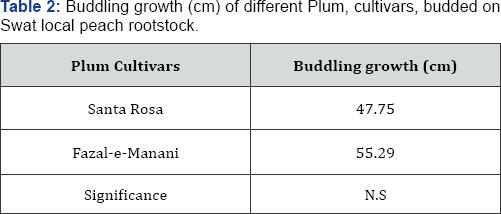To Study the Bud Take Success and Budding Growth of Plum Cultivators on Peach Swat Local Root Stock-Juniper Publishers
Juniper Publishers- Open Access Journal of Environmental Sciences & Natural Resources
To Study the Bud Take Success and Budding Growth of Plum Cultivators on Peach Swat Local Root Stock
Authored by Jalal Amin
Abstract
The experiment was carried out at Agricultural Research Institute Tarnab, Peshawar, during the year, 2015, under the internship program. This project dealt with two plum scion cultivars i.e. Fazal-e-Manani and Santa Rosa that were budded on Swat local peach rootstock. The experiment was laid out in Randomized Complete Block Design with one factor and four replications. The parameters studied were Bud take success (%) and Budding growth (cm).Both cultivars on Swat local peach rootstock showed non-significant effect to Budding growth, while it had significant variation in Bud take success. The bud take success (76.42%) was recorded in Santa Rosa and (71.10%) in Fazal-e-Manani cultivar and budding growth of Fazal-e-Manani was 55.29 cm and in Santa Rosa Plum was 47.75 cm.
Keywords: Budding; Growth; Cultivars; Plums
Introduction
Plum (Prunus aomestica) belongs to the genus prunus, subgenus Prunphora (plum and apricot) ofthe family Rosaceae Malik. It is a deciduous fruit commonly known as stone fruit. It is a true fruit and is characterized by having a distinct three-layered peri carp-an exocarp, mesocarp and a stony endocarp, which enclose the seed). It is a major fruit of Pakistan and is grown mostly in temperate regions, while some low chilling varieties may be grown in the milder parts of sub-tropical regions of Khyber Pakhtunkhwa and in Quetta and Qallat divisions of Baluchistan, and there is some acreage in the Muree hills of Rawalpindi District in Punjab Malik. The plum includes several species whose native habitats are widely separated. The most important species is domestica; it was presumably from the area between the black and Caspian seas and the adjoining regions of Persia and Asia Miner that this species spread westward. Apparently it was not domesticated as early as other fruits. According to the earliest record in which the plum is mentioned, the species dates back over 2000 years. The native America plums are assumed to have been used as food by the Indians. Dissatisfied with quality of these native species, the colonists imported plum seeds and varieties from Europe [1].
There are about 15 cultivated species of plum, of which Prunus domestica (European plum) and Prunus salica (Japanese plum) are the most common. Important varieties produced in the various regions of Pakistan are European plums (Fazal- e-Manani, Grand Duke, Gauzles and Formusa) and Japanese plums (Burbank, Wickson and Methley).Plum is very tasty fruit and is available in green and in red color. Green plum is picked from the orchards for long distance shipment while red colored plum is used in immediate markets as a finished consumer’s product. Usually, red, tended and fresh looking plum high price in the market. Plum is very tender and perishable, having high percentage of water content (86.6%), calories (48g), protein (0.5g), fats (0.2g), carbohydrates (12.3g), Vitamin A,B,C (2.5, 0.03 and 6mg respectively), Niacin (0.5mg), Riboflavin (0.03mg), Ca (12mg), P (18mg), Fe (0.5mg), Na (1.0mg) and K (170mg) per 100 g of edible portion [2-6]. All this composition makes plum a good nutritious fruit (Westwood, 1978). In Pakistan plum is a popular fruit usually grown in the temperate regions and can also be grown in sub-tropical regions.
A number of rootstock such as peach (Peshawar and Swat Local), Bitter almond, Desi plum (Myrobalan) are used for different soil and climatic conditions, but the most important rootstock in Khyber Pakhtunkhwa (KP) is the peach (Swat local), and in Baluchistan, Bitter almond is used as a rootstock for plum. The different counties are using different rootstock according to (2017) their prevailing agro-climatic conditions. In Peshawar, plum is commercially propagated by T-budding using rootstock of the same genus Prunus. Budding practice usually starts from mid of May to end of July. Peach rootstocks can tolerate a wide range of soils performed well in soil fertile, well drained soil with pH range of 6.7-7.0. In nursery production the common procedure, to grow rootstocks from seed to get the seedling [6-10]. In this part of the world plum are usually budded on peach rootstock. The growth of plum is very good on peach root stock. In the view of as or facts in experiment is designed to study the bud take success and budding growth of plum cultivars on swat local peach rootstock with the following objectives.
Objectives
This research work is carried out with the following specific objectives: To study the bud takes success of plum varieties on (peach swat local) rootstock. To study the budding growth of plum varieties on (peach swat local) rootstock [10-14].
Materials and Methods
The experiment on "To study the bud take success and buddling growth of plum cultivars on peach rootstock" and was carried out at Agricultural Research Institute Tarnab Peshawar during the year 2015. There were two plum scion cultivars i.e. Fazal-e-Manani and Santa Rosa in experiment. The experiment was designed as Randomized Completely Block Design with one factor.
Experimental Protocol
The land was ploughed in the month of October. Five tractor of well rotten Farm Yard Manure (FYM) were applied per hectare. Then the land was leveled and divided into the required experimental plots. The seed of rootstocks peach 'Swat local' were treated with Diathane M-45 @2g/lit before sowing and were sown in the month of November. The row-to-row distance was kept 75cm and Seed to seed 1-2cm. Di-Ammonium Phosphate (DAP) and Urea were applied with 1:1 parts at the rate of 50kg per acre each. Weedicide i.e., Stamp was applied as pre-emerged Weedicide. The seed germinated in the month of February (15th Feb to 20th March). When the seedlings attained a pencil size thickness (10-15mm), then 2nd dose of Urea @ 1bag per acre was applied and plots were immediately irrigated after fertilizer application. All the cultural practices were done accordingly and uniformly in all plots. The budding was practiced in the last week of June. Budding was done at a height of 20cm from the ground level and opposite position from the sun light. After budding the budded portion of the stock was wrapped with polyethylene plastic in a way that the bud remains uncovered and easy to sprout [14-17]. The experimental plants were regularly inspected and when the budding union was seen successful, then wrapping materials were removed. The terminal parts of seedlings were bent down in opposite direction of the bud. When the buddlings attained 15-20cm height, the stock above union was removed. The experimental plot was kept clean regularly from weeds. The following data were recorded during the experiment.
The following parameters were studied in the study:

Bud takes success (%)
After complete sprouting and success growth of scion the percent bud take success was calculated at the end of growing season by following formula.

Buddling growth (cm)
The length of the budded (scion for each varieties) of thirty (30) randomly selected plants was taken with the help of measuring tape from the bud union to the tip of the budding and then mean was calculated.
Statistical Analysis
The data were statistically analyzed as Randomized Completely Block Design on factor by using Statistics 8.1 software.
Results and Discussion
The data were collected on the following results were obtained for bud take success percentage and budding growth.
Bud Take Success (%)
The data pertaining to bud take success are given in (Table 1) while (Table 1a) indicates the analysis of variance. The analysis of variance showed that there was significant variation in bud take success existed between cultivars. However, the mean of percent bud take success for cultivars revealed that comparison higher bud take success (76.42%) was recorded on Santa Rosa cultivar than Fazal-e-Manani which was (71.10%). Santa Rosa was superior than Fazal-e-Manani in term of bud take success. This may be due to the variation in genetic make of variety [2]. These results are in line with [2] who reported that plum varieties budded on swat local peach rootstock significantly responded to bud take success (%).

***highly significant

Buddings Growth
The data regarding buddings growth are given in (Table 2) while (Table 2a) represents the analysis of variance. The analysis of variance indicated that different cultivars on the same rootstock exhibited non-significant difference with respect to budding growth. This mean that both scion cultivators showed equal budding growth responses on swat local peach rootstock, similar finding was reported by. Inayat Ullah Khan (2014) who reported that effect of budding growth of peach cultivars and found non-significant result.

N.S=Non-Significant

Grand Mean= 51.524, CV =6.97
Conclusion
In this experiment two scion cultivars of plum were budded on Swat local peach rootstock. There was significant variation in bud take success but non-significant for budding growth. Santa Rosa performed better in bud take success.
For more articles in Open Access Journal of Environmental Sciences & Natural Resources please click on: https://juniperpublishers.com/ijesnr/index.php




Comments
Post a Comment